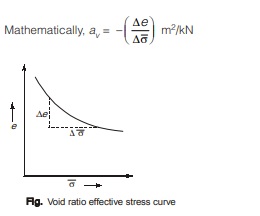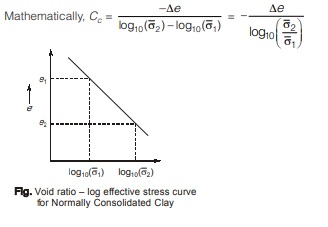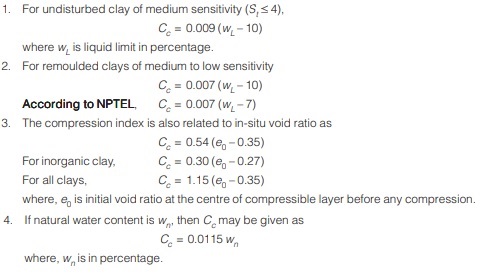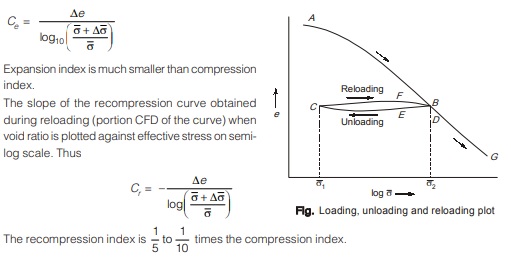Consolidation
The decrease in volume of fully saturated soil by squeezing out of the pore water on account of gradual dissipation of excess hydrostatic pressure induced by an imposed total stress, is defined as consolidation.
Total consolidation of a soil is divided as follows:
(a) Primary Consolidation
- This process begins when soil is fully saturated. Due to increase in effective stress over the saturated soil mass, pore pressure increases. As a result, expulsion of pore water occur if drainage facility is provided. Primary consolidation is completed when expulsion of pore water stops.
- During the process of consolidation, soil remains saturated (S = 1) and flow of water is under laminar condition, i.e., Re < 1. [Darcy’s Law is applicable.]
- The volume of expelled water is equal to decrease in volume of soil which can be measured. Since soil mass is considered semi-infinite, therefore, change in volume is equal to the change in depth [Semi-infinite means infinite area and finite depth, thus area remains constant.]
- Due to primary consolidation, settlement occurs which is time dependent. The time required will depend upon:
1. Rate of application of load
2. Coefficient of permeability of soil
3. Drainage facility available (One-way or Two-way drainage)
4. Length of drainage path which depends upon the thickness of soil and type of drainage. - If on a saturated soil mass, increase in effective stress is ∆σ1 , then initially it will be taken by pore water. Hence, increase in pore pressure (EXCESS PORE PRESSURE) ui = ∆σ1
- If expulsion of pore water takes place, then excess pore pressure reduces and when expulsion of water stops, then excess pore pressure becomes zero. At this stage, primary consolidation is complete for increased effective stress, 1 ∆ σ .
- If effective stress is further increased by 2 ∆ σ , then consolidation will again occur and so on.
(b) Secondary Consolidation:
- After completion of primary consolidation when expulsion of pore water is stopped and load continues to act, then at very slow rate further volume change may be recorded which is due to plastic readjustment of solids. This is called Secondary Consolidation and it is time-dependent which is much slower than primary consolidation.
- Secondary consolidation is more in plastic soils and in highly plastic clays, it may be 10-20% of total volume change. In coarse grained soils (Gravels and sands), it is negligible.
Normally Consolidated Soils
Normally consolidated soils are those which are loaded for the first time to the present applied effective stress. It means past applied effective stresses were lower than the present applied effective stress. Such soils are more compressible.
Over Consolidated Soils
Over consolidated soils are those which have been subjected to effective stress in the past greater than present applied effective stress in past. The over consolidation/normal consolidation can be differentiated using over consolidation ratio.
Over consolidated soils are also called Pre-consolidated or Pre-compressed soils. Such soils are less compressible and have greater shear strength and more stability.
Some of the causes of Over-consolidation or Pre-consolidation are as follows:
- In the past, over burden pressure or surcharge was placed, which is removed later.
- Continuous erosion of overburden soil.
- Melting of glacier which covered the soil mass in past.
- Effect of capillary pressure which is later destroyed by rise of water table.
- During the drying of soil, effective stress reduces and soil becomes over consolidated. This process is known as ‘Dessication of soil’.
- If initially soil was subjected to downward seepage pressure but later seepage stops, then effective stress reduces.
- If there was no seepage but later vertically upward seepage occurs, then also the effective stress reduces.
- Due to effects of tectonic forces.
Over Consolidation Ratios (O.C.R.)
- It is defined as the ratio of maximum applied effective stress in the past to the present applied effective stress.

Coefficient of Compressibility (av)
- The slope of effective stress v/s void ratio curve on arithmetic scale is called Coefficient of Compressibility.

- The coefficient of compressibility decreases with an increase in the effective stress. Hence, soil become stiffer on effective stress increment and curve becomes flatter.
Compression Index (Cc)
- If void ratio is plotted on y-axis on arithmetic scale and effective stress on log scale on x-axis, then the curve for normally consolidated clays is found to be a straight line.
- The slope of this curve is constant, which is called coefficient of compression or compression index.

- Compression index has significance only for Normally consolidated clay.
- It does not depends upon effective stress. It has a constant value for a particular type of soil.
Determination of Cc

Coefficient of volume change (mv)
- The coefficient of volume change is defined as the ratio of unit volume change per unit increase in effective stress.

- Coefficient of volume change and coefficient of compressibility are not constant parameters.
Expansion and Recompression Index
- The expansion index or swelling index is the slope of the void ratio vs log (effective stress) plot during unloading. (portion BEC of the curve)


